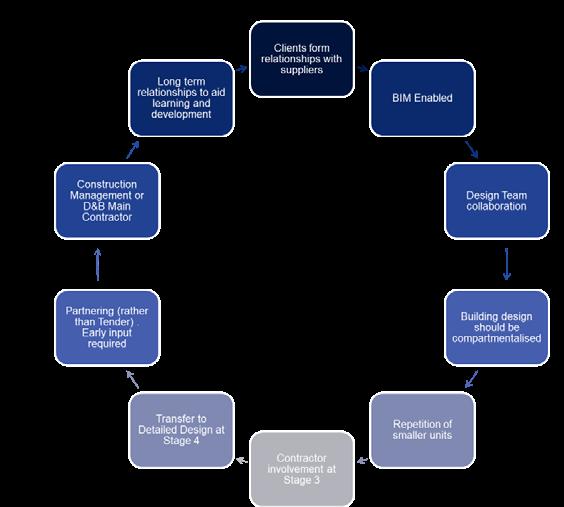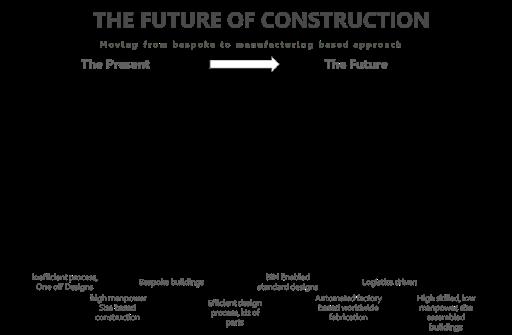
4 minute read
Conclusions Nextsteps
Conclusions & Next steps
The Client’s Role is key, as always.
In this context their leadership will no doubt make a difference. Some useful aspects include: • A collaborative approach to procurement • Identifying opportunities for common solutions to designs across programmes and portfolios • Setting Minimum levels of pre-manufactured value (PMV) • Removing barriers to high performance by designers and suppliers • Expecting (demanding) evidence of continuous improvement and supply chain development from their direct suppliers (both consultants and contractors).
Figure 8.1 New Project Cycle
The PM Role
The Project Manager Role will continue to control most, ifnot all ofthe expenditure. Their attitude towards making this happen rather than continuing to deliver projects as they have been before will make a substantial difference.
Initiate design for manufacture and assembly studies at an early stage and take on board the different implications for setting up the project plan and cash flow assumptions.
Procuring for packages in a way that at least does not disadvantage offsite supply options is necessary to get the most value from this. (Avoid using designs which have already restricted the offsite opportunity).
Establish lean visual management tools for monitoring and controlling progress but aim not to exploit the additional transparency this gives into unfairly penalising suppliers for problems that may have been less apparent if a traditional approach had been followed. Rather look to use the learning to drive continuous improvement.
Focus attention on managing the onsite/offsite interfaces (e.g. physical/timing/logistics).

Figure 8.2 Designing for Offsite
The Wider Team’s Role
Following the Road Map set out by the CLC will require a coordinated effort. To achieve this the industry will need to come together and adopt common approaches and standards. We would encourage:
Action Focus upon delivering value as viewed from the client’s perspective, not restricted to the triumvirate of time, cost and quality. Consider climate change, whole life costs and impacts on their business operations. improve construction productivity.
Apply lean principles to everything we do.
Need for individual action, collaboration and common platforms Development of the Construction Innovation Hub’s Construction Quality Planning (CQP) process.
CQP is based upon Advanced Product Quality Planning (APQP), a process alreadyused widely across leading manufacturing sectors like aerospace and automotive.
It defines an approach for those firms which supply the construction sector with new products and assemblies that form part of tomorrow’s offsite manufactured buildings. The development and use of open standards such as buildingSmart International’s for software agnostic exchange of information, including the buildingSMart Data Dictionary A partnering approach to delivering buildings Outcome Better decision making. More satisfied clients.
Eliminate non-value adding activities and the Digital Supply Chain. and
CQP ensures parts are fit for purpose, e.g. they comply to the specification for a “platform” into which they are integrated.
Improved information management. opportunities to work internationally. More
Adopting new forms of contract and alignment ofstakeholders’ objectives. better
Figure 8.2 An Offsite Centric Response
The New Skills Required
This new industry will require new skill sets but achieve higher productivity, higher quality, better health & safety statistics and improved sustainability.
Manufacturing & process PM & Logistics
Design management
An approach that delivers value throughout the supply chain by understanding the benefits ofMMC, match these to markets advises stakeholders and design select and monitor implementation
Construction Sector
Materials expertise: steel, light gauge, precast, timber
QA & compliance Traditional players exit
Manufacturing based approach
Disruptors and new industry players enter
Figure 8.3 Offsite Skills Requirements
What the Construction Sector Could Look Like
The Benefits of Offsite Construction are set out in CIRIA’s recent report “Methodology for Quantifying the Benefits of Offsite Construction”. They are so widespread that it has been suggested that the only reason offsite methods are not more widely utilised is due to embedded behaviours. The current crisis could well be the catalyst to break those behaviours and reform the industry.

Figure 8.4 What the Industry Could Look Like
As demonstrated by interior design and fit-out, standard products do not have to result in uninteresting buildings. Let’s demonstrate how exciting buildings and facilities may be delivered efficiently, safely and predictably to a high-quality standard, exploiting offsite methods.
Let’s do this in ways which help us recover from the impact of the current pandemic. Let’s take a little time to re-plan our current projects where we can accelerate them. Let’s take a different approach to specifying and designing our following projects. And let’s be open minded about re-inventing our industry over the next two years.
Incorporating more manufactured components and assemblies is most easily achieved if strategies are developed across programmes of projects and project portfolios. The CIH is currently developing its Construction Quality Planning (CQP) process which will help us do this reliably. It will involve thinking about projects to design products as well as our usual focus upon projects to deliver buildings and infrastructure. This will often need to be done away from the critical path of facility delivery projects. To get the most out of this, it will need major clients to analyse their project pipelines and their suppliers to reconsider their delivery processes and how their supply organisations need to develop. We should be thinking about how we are going to reinvent whilst we are resetting. Let’s turn this crisis into a driver of sustainable and continuous improvement. Let’s recognise and grasp the opportunity.
info@buildoffsite.com www.buildoffsite.com 02075493305





